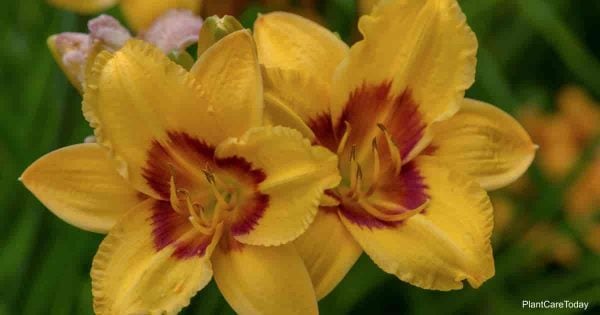Daylilies (hemerocallis) are summertime standouts in any garden – more on daylily care here.
If you still think of daylilies as dull bronze or slim-petaled yellow flowers, there is a treat in store for you.

Wide Range of Colors & Flower Forms
Modern hybrid daylilies come in a wide color range – pale cream, melon, pink, yellow, orange, red and near purple. The majority are self colored but there are bicolored, eyed and banded varieties.
Flower forms, too, are intriguing. There are wee ones measuring two to three inches across the face, middle sized six-inchers, great big ones to nine or ten inches, and some doubles. There are slender-petaled “spiders,” star-cup or trumpet-shaped flowers, and those with wide flat faces. You can buy short, medium or tall ones tailored to your landscaping needs.
Evergreen Daylilies Southern Favorites
Evergreen varieties, with foliage staying firm the year around, are favored by most Southern gardeners. Foliage on dormant varieties wilts and browns after the first hard frost, making these perennials ideal for gardeners in colder climates.
Dealer catalogs list color, approximate height and blooming season. If a variety is evergreen it is listed as such. All others are hardy types.
Use daylilies to brighten up a driveway, as a pool-side planting or to perk up a patio. Plant a clump of pale yellow, melon or pink ones at the base of a trellis of ‘Heavenly Blue’ morning glories or blue-flowered clematis.
Use them as specimen plantings, as bright splashes of color against dark evergreens or as a featured part of your perennial border. They’ll provide that needed drift of color after your irises and peonies have flowered.
Individual flowers on most hemerocallis varieties last but one day, but mature plants may set from 25 to 60 buds so you will be greeted each morning with a crop of crisp, fresh flowers.
Question: Is it injurious to daylily plants if the bloom spikes are cut immediately after they have finished blooming, or should they die down naturally? NK, Kentucky
Answer: There is no injury to daylilies if the bloom spikes are removed immediately after they have finished flowering. In fact this should help them, although they usually spread and thicken up rapidly enough without this being done.
Daylilies Good In Arrangements
Daylilies are good in arrangements. If the arrangement is to last but one day, you needn’t bother putting them in water. With this in mind there’s no limit to your choice of container or method of displaying them.
If you want a more permanent arrangement give the daylilies a backing of handsome foliage. As flowers wither, pick them off and replace them by pinning fresh ones to the flower scapes. Heavy brass pins, size 28 to 32, which you can purchase from a stationery store will do the trick.
Older hemerocallis such as flava (the Europa lily) would grow in any soil, even along a dusty highway. Newer day lily hybrids should receive the same good care you give any valued garden subject.
Caring For Daylilies – Planting To Bloom
These perennials respond beautifully to humus-enriched soil, thorough watering during their bud setting and blooming period, fertilizing in spring and fall.
Plant daylilies any time the soil is frost free.
Examine a newly purchased fan or clump and you can tell its planting depth by the pale green color at the base of the leaves. Replant at this depth. If in doubt, plant them so about an inch of the crown (leaf base) is below the topsoil.
You’ll get maximum color and texture from red and pastel daylilies if you plant them where they receive some shade from taller perennials or shrubs. Others can be planted in full or partial sun.
Hemerocallis Pests
Hemerocallis garden enemies are few, but some growers have reported thrips damage. Thrips scrape away and scar petal and leaf tissue.
A spraying of Malathion, or Neem insecticide oil makes short work of them.
Formerly some species and older varieties increased so rapidly that they soon took over the garden. Not so with the newer hybrids most of them increase rather slowly.
Hemerocallis are at their best when grown in large clumps so they needn’t be divided for five or more years.
Propagate through division, rooting proliferations (little plantlets which sometimes grow from the stems) or through seeds.
Ref: FG061959